I've been lucky these last few months. First, Karen and Steve visited over New Year's, and then just last week my old friend Duncan was here for a week doing research for a book. He arrived with a list of things he wanted to do and see, much of which overlapped with things that have been on my own list for some time. This meant that I spent a few days - including one exceptionally jam-packed Sunday - doing interesting touristy things and generally hanging out and catching up, all of which was quite excellent and highly bloggable.
First on the list was a trip slightly south and east from Central London to the tiny suburb of Chislehurst. It's a unremarkable little spot on the map notable only for the existence of Chislehurst Caves. (Though perhaps the residents of Chislehurst might protest that their little corner of London is exceptionally wonderful in many other ways. Of course they'd be wrong.) In fact, the site should really be known as Chislehurst Mines because they are not a natural cave system at all but instead a series of man-made tunnels dug into the huge reserves of chalk and flint that surround and support Chislehurst. Chalk has been mined by humans for millennia - it's soft enough that it can be worked with very primitive tools, so even Stone Age societies could dig for it. It's used for the production of lime, which is creating by heating the chalk (who knew?). Lime is the basis of plaster of Paris, is used in cement, and becomes whitewash when mixed with water. And the acidic agricultural fields around Chislehurst were "sweetened" by the application of lime - an alkaline that counteracts the acid in the soil. Flint, which occurs in seams in the chalk was also mined and used to create stone tools, for gunflints and as a building material. The earliest recorded mention of mining at Chislehurst dates back to 1250, so some of the tunnels could be 750 years old.
The visitor's centre at the Caves is a pleasant building equipped with heat, toilets, a small gift counter, and a barely passable café. I say it was barely passable for two reasons. First, because the coffee came from one of those machines where you press the button that says "Latté" and are rewarded with a warm cup of something very much like coffee but generally sort of dispiriting. Second, because of a rather amusing series of events that happened after Duncan and I arrived five minutes too late for the 10am tour and elected to warm ourselves and pass the time with said dispiriting coffee and a snack. Duncan ordered beans on toast, and after sitting down with our warm cups of coffee-like substance an oddly long interval of time passed wherein no beans on toast appeared from the totally underworked kitchen. Finally Duncan went to inquire of the skinny counter guy regarding the whereabouts of his beans on toast, and the conversation went something like this:
Chalk and flint mining in the tunnels probably became unprofitable and ceased around the early 19th century, and though the caves enjoyed a brief stint as a storehouse for smugglers, that use stopped by 1840 when heavy taxes on smuggled goods were removed, thus also removing the smugglers. The caves first became a tourist attraction in the Edwardian era, but with the start of World War I they were turned into an ammunition depot for the overflow from Woolwich Arsenal.
More interesting though was the use of the tunnels during the Second World War as a massive bomb shelter. The government initially discouraged people from sheltering underground during bombing raids for fear that they might simply refuse to leave. Ever. Despite this, within days of the start of the Battle of Britain in early September of 1940 people were arriving at the caves by the thousands. At first facilities were rudimentary - people slept on the floor of the caves and had only candles, torches and oil lamps for light. But, in the true war time spirit it only took a few weeks for there to be a functioning underground society complete with electric lighting, ventilation and sanitation.
Eventually the caves sheletered more than 15,000 people, who enjoyed ammenities such as a fully staffed medical centre, hair salon, church and two different cinemas. The caves even had their own Brownie, Guide and Scout groups. People remained resident at Chislehurst caves for close to five years because even after the end of hostilities many had nowhere to return to. And, in the entire time the caves were used as wartime shelter, only two people died (and not due to enemy action). Even a direct bombing hit on the caves was barely noticed by those below, causing only a flicker in the lights and a dusting of chalk from the ceiling. There was even a baby girl was born in the shelter who, lamentably but perhaps inevitably, was given the middle name "Cavena".
After the shelter was closed the caves went thorough a brief stint as a mushroom farm but next gained noteriety - bizarrely - as a live music venue. Apparently the particular acoustics in the tunnels meant that as many as five different bands could be playing at the same time without disturbing one another. And we're not talking about small time local garage bands either. Big names like David Bowie, Jimi Hendrix and Pink Floyd played the caves. Our guide said he remembered seeing Led Zeppelin on this stage:
Of course there are ghost stories that go along with the caves too, many of which centre around a "£5 Challenge" daring anyone to spend a night alone in the caves and claim their money. Apparently, despite several attempts, and at least one seizure and evacuation by ambulance, the prize was never claimed. Now the owners allow people to use parts of the complex for live role playing games like Dungeons & Dragons, which sounds like it would be immensely fun and cool, in a supremely geeky way.
Wandering through the caves was really quite evocative and creepy at times. Cleverly, the people in charge do not allow you to use flashlights - only the guide is equipped with one. Instead visitors are invited to carry oil-fuelled miner's lamps, which adds immeasurably to the atmosphere. Once or twice Duncan and I ended up dawdling a bit behind the main group and it didn't take long before they'd disppear completely down a side passage. Those miner's lamps don't throw a great distance, so it was easy to be left almost completely in the dark with the muttering sounds of the rest of the group fading quickly. It was a powerful incentive to speed the hell up.
And because the chalk walls of the caves are so soft there are lots of carvings people have created, some small and primitive, others large and remarkably elaborate.
The tunnel system really is extensive and labyrinthine; we saw just a tiny portion of it. (During the war years, to aid in navigation, the tunnels had names like street names - including the evocative "Lumbago Alley" One assumes the ceiling there must have been quite low.) We ended up back at our starting point after about 45 minutes of walking, and during that time we only covered about a mile so; it would take years to become really familiar with all the nooks and crannies.
I'd say Chislehurst Caves was definitely worth the trip. It was interesting and quirky and atmospheric and thoroughly enjoyable. It was even reasonably priced and easy to get to so really it ticks all the boxes for an excellent Day Out. Except, perhaps, the box labelled "beans on toast".
P.S. I should really mention this more often, but as with most blog posts, you can head over to my Flickr page and see the photos that didn't make it into this post, but may be mildly diverting now that you've read the blog. Unsurprisingly, photos from today's post are in a set called "Chislehurst Caves"
First on the list was a trip slightly south and east from Central London to the tiny suburb of Chislehurst. It's a unremarkable little spot on the map notable only for the existence of Chislehurst Caves. (Though perhaps the residents of Chislehurst might protest that their little corner of London is exceptionally wonderful in many other ways. Of course they'd be wrong.) In fact, the site should really be known as Chislehurst Mines because they are not a natural cave system at all but instead a series of man-made tunnels dug into the huge reserves of chalk and flint that surround and support Chislehurst. Chalk has been mined by humans for millennia - it's soft enough that it can be worked with very primitive tools, so even Stone Age societies could dig for it. It's used for the production of lime, which is creating by heating the chalk (who knew?). Lime is the basis of plaster of Paris, is used in cement, and becomes whitewash when mixed with water. And the acidic agricultural fields around Chislehurst were "sweetened" by the application of lime - an alkaline that counteracts the acid in the soil. Flint, which occurs in seams in the chalk was also mined and used to create stone tools, for gunflints and as a building material. The earliest recorded mention of mining at Chislehurst dates back to 1250, so some of the tunnels could be 750 years old.
A picture of some of the larger tunnels
DUNCAN: Excuse me, I also ordered beans on toast.So as I said, Chislehurst Caves Café is not exactly a centre for excellence in a culinary or customer service sense. However, I digress. Back to the caves. Guided tours are run every hour on the hour, last about 45 minutes, and cost a mere £6. And the caves are a pleasant and constant coolish room temperature, which was quite nice on a cold day. The tunnels themselves are extensive - estimated at about 20 miles in total.
GUY: Oh, yes. Err... I though it was just toast.
(interior monologue) ME AND DUNCAN: Even if it was just toast, which it wasn't, you've still patently produced no toast at all, beaned or otherwise.
DUNCAN: No, it was beans on toast.
GUY: Ah, ok sorry. So did you want beans on that toast?
DUNCAN: (spluttering in disbelief and speaking very slowly) YES. BEANS ON TOAST.
The map of the caves. The areas called "Romans", "Saxons", and "Druids" are names thought to have been assigned by an enthusiastic local resident in the early 20th century and almost certainly have little to do with the actual origins or uses of the tunnels.
A recreation of an ammunition storage area in the caves. There were quite a few tableaux like this which were not badly done, especially considering that I think they were all created by the family who own and run the caves.
Bunk beds were installed and people could doss for a penny a night or sixpence a week, as long as they followed the posted rules.
The posted rules.
Surviving signage
One of the live music stages. There were also dancefloors.
Wandering through the caves was really quite evocative and creepy at times. Cleverly, the people in charge do not allow you to use flashlights - only the guide is equipped with one. Instead visitors are invited to carry oil-fuelled miner's lamps, which adds immeasurably to the atmosphere. Once or twice Duncan and I ended up dawdling a bit behind the main group and it didn't take long before they'd disppear completely down a side passage. Those miner's lamps don't throw a great distance, so it was easy to be left almost completely in the dark with the muttering sounds of the rest of the group fading quickly. It was a powerful incentive to speed the hell up.
The table of lighted lamps at the entrance to the main tunnels.
This is an interpretation of the Tree of Life
And of course this is Spider-Man. No, really, it's Spider-Man.
Not all the carvings are antiques.
The tunnel system really is extensive and labyrinthine; we saw just a tiny portion of it. (During the war years, to aid in navigation, the tunnels had names like street names - including the evocative "Lumbago Alley" One assumes the ceiling there must have been quite low.) We ended up back at our starting point after about 45 minutes of walking, and during that time we only covered about a mile so; it would take years to become really familiar with all the nooks and crannies.
I tarried a bit at the end in order to get a few more photos and ended up being the last one out. This is Duncan, returning through the long access hallway to retrieve me.
Or perhaps to loot my body for cash and small electronics.
I'd say Chislehurst Caves was definitely worth the trip. It was interesting and quirky and atmospheric and thoroughly enjoyable. It was even reasonably priced and easy to get to so really it ticks all the boxes for an excellent Day Out. Except, perhaps, the box labelled "beans on toast".
P.S. I should really mention this more often, but as with most blog posts, you can head over to my Flickr page and see the photos that didn't make it into this post, but may be mildly diverting now that you've read the blog. Unsurprisingly, photos from today's post are in a set called "Chislehurst Caves"


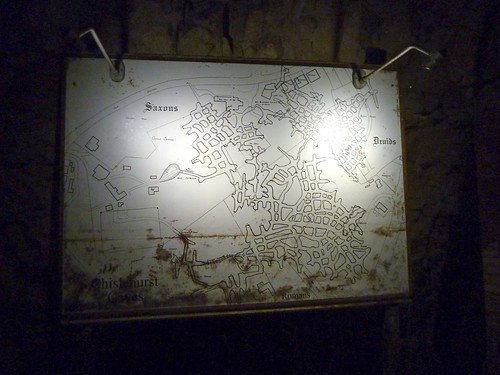
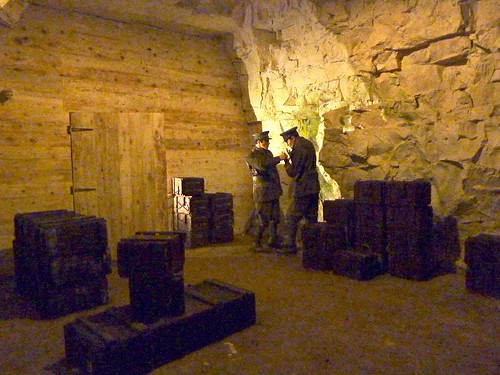


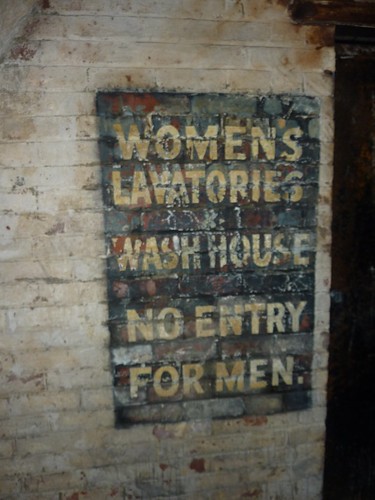
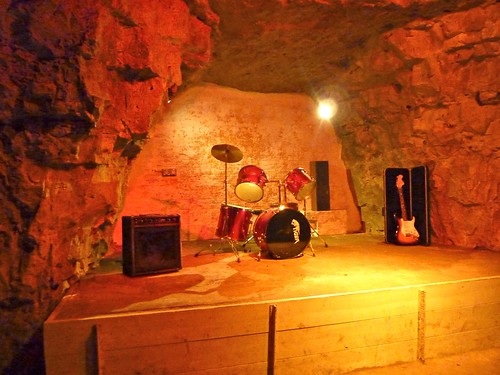
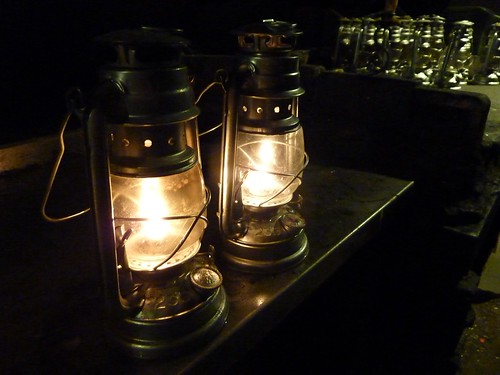
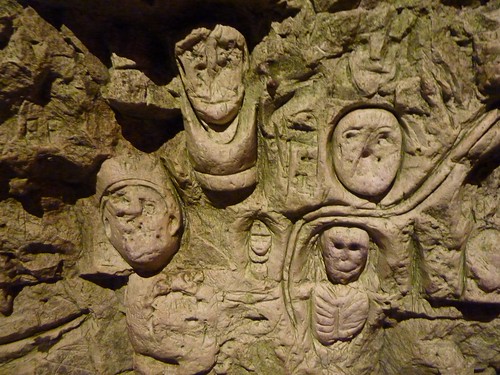
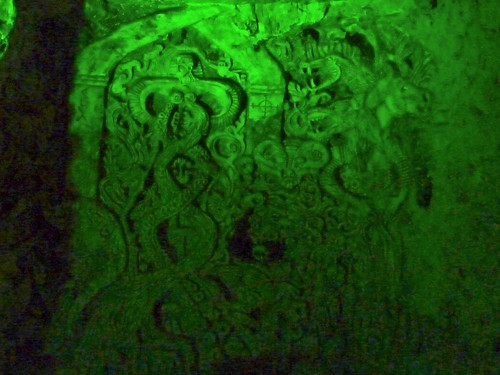

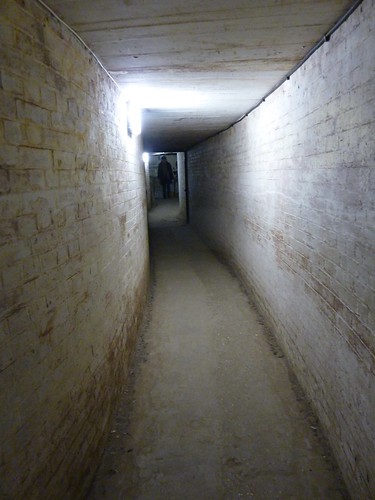


0 Comments:
Post a Comment